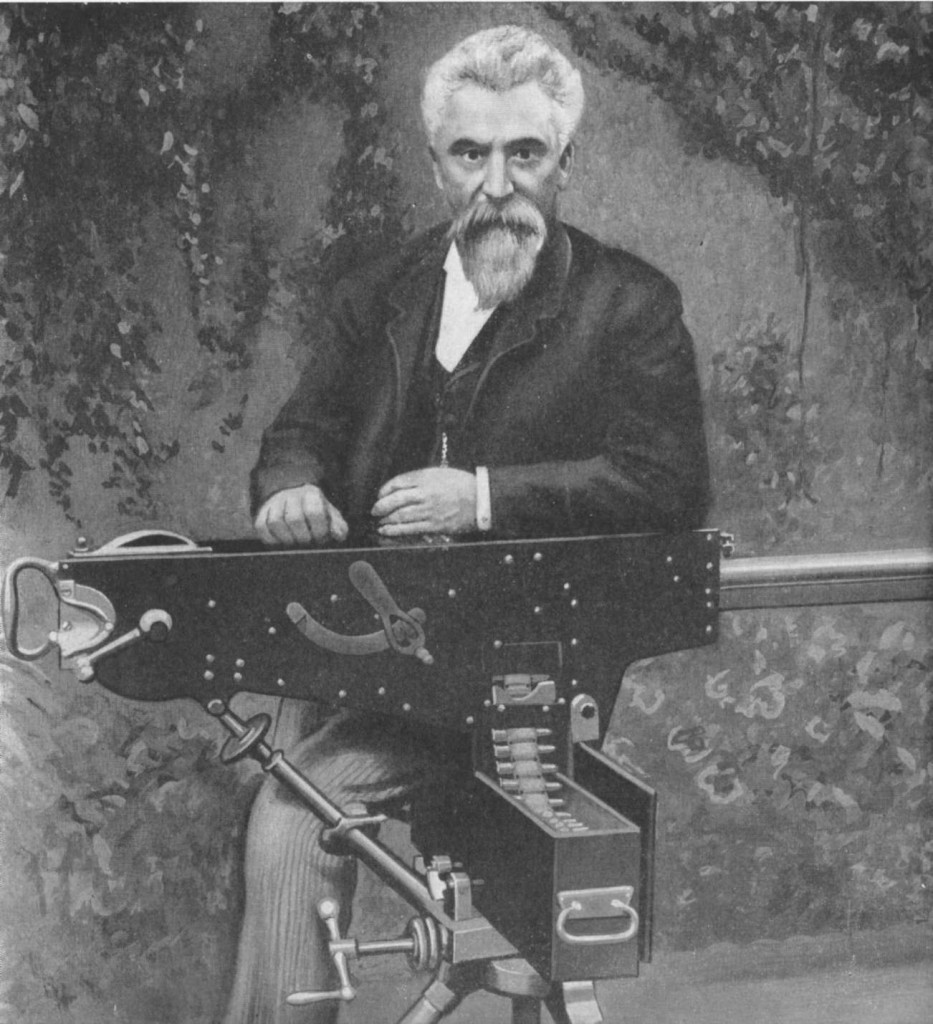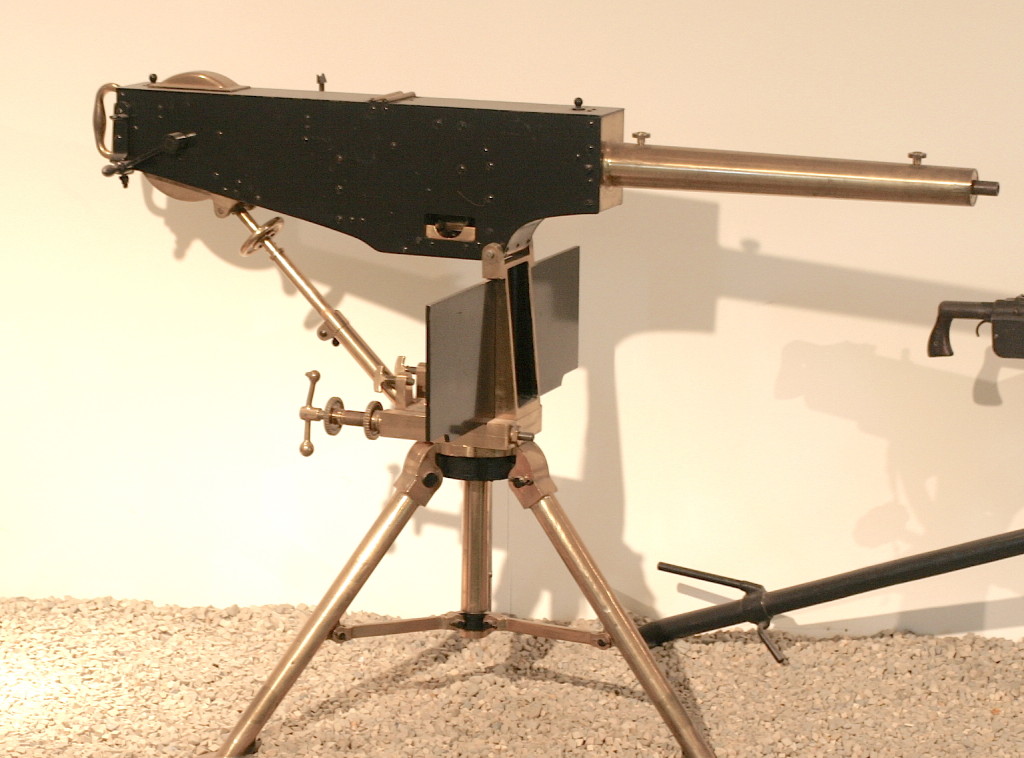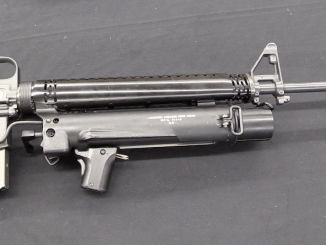I am going to start an intermittent series of posts on the various different types of Maxim machine guns over the next few months – there are a whole slew of them, and I have good photos of a bunch of different variants. Hopefully it will be a good reference for both production history and identification – and it will begin with the first practical machine gun Hiram Maxim made: his “Prototype”.
Maxim began his experiments into self-loading firearms with a patent for converting a Winchester lever action into a self-loading arm, and we will address that particular gun at another time. His next step was a gun he called the “Forerunner”, which used a proprietary piston-primer type of ammunition and a hydraulic buffer system – we will also save discussion of that developmental dead end for another day.
On January 3, 1884 Maxim filed a patent covering 12 different claims relating to automatic firearms, the broadest one literally covering any use of gas pressure being used to operate the mechanism of a gun (he would later spend a lot of time fighting patent infringement claims, not surprisingly). At this time, Maxim had a workshop at 57D Hatton Garden, London, where he built his guns. The first Prototype was a clever and creative gun, built with inspiration from Maxim’s own ideas and from existing manually operated guns, most significantly the Gardner (from which Maxim took a variation on the flywheel connected to the bolt mechanism).
The very first example gun had a unique trigger mechanism which was actually a swinging lever which would both fire the gun and control the rate of fire – which could be as high as 600 rounds/minute and as low as 1 or 2 rounds/minute. This was done by the lever adjusting the mainspring tension. The rearward travel of the bolt mechanism was absorbed by connecting it to a rotating bell crank, although early experiments showed that having the crank rotate continuously in one direction caused the system to speed up uncontrollably, so the working version of the gun had a crank which would rotating about 270 degrees with each shot, and then reverse direction. This was connected to a handle for manual cycling, and when firing this handle would whip back and forth at high speed.
In a somewhat humorous side note, at some of Maxim’s early demonstrations, observers would assume that this handle was used to fire the gun like a Gardner or Gatling and express skepticism that it could be spun by hand at Maxim’s claimed 600 rpm – only to be quite taken aback by the blur of motion when the gun was fired.

Maxim was also the first person to build a water jacket around his gun’s barrel to keep it cool, after noting that water acts as a much better heat sink than steel (which is to say, it takes more thermal energy to raise the temperature of water than it would to raise the same mass of steel by the same number of degrees).
Maxim made a couple examples of the Prototype gun once he deemed the action reliable and durable, and then proceeded to widely announce his creation in the press, where it receiver much acclaim.
Normally I would need to spend a lot of time trying to explain the details of the action of the Prototype, but in this case we are lucky to have a computer-animated model available which does a fantastic job showing all the elements of the gun. I don’t know the person who put this model together, but they did outstanding work (and did it for several other guns as well):
It is worth noting that this gun was designed and publicly demonstrated in 1884 – still a year before the invention of smokeless gunpowder. All of Maxim’s work on these guns was done with the black powder .45 Gardner-Gatling cartridge (485-grain bullets over 80 grains of black powder), which makes his feat of a reliable machine gun even more impressive. In fact, Maxim filed additional patents around this time for devices to filter smoke particulates and do other things in an effort to ameliorate the problems of black powder in repeating arms. These would be rendered moot by the smokeless powder that was just around the corner, though.
In order to best exploit the automatic fire his gun was capable of, Maxim also had to develop a feed mechanism more sophisticated than the vertical feed towers of Gatling and Gardner manual guns. He actually developed two such systems; a belt feed and a drum feed. The drums were to sit atop the gun, and mechanically were quite similar to the Lewis drums that would come decades later. However, he decided the belt feed was more practical, and perfected it while abandoning the drum feed.
Ultimately Maxim fired more than 200,000 rounds of ammunition through the Prototype guns with minimal serious problems – quite the achievement! The gun’s size (just over 5 feet long) and complexity made it unlikely to win military interest, however. Maxim would take the advice of his friend Sir Andrew Clark (Inspector-General of Fortifications for the British government) and return to the drawing board until his gun could be disassembled completely without tools in mere seconds. We will look at those changes in the next episode of the Maxim story…





Joseph Hilaire Pierre René Belloc (1870-1953): “Whatever happens we have got the Maxim gun. And they have naught.”
Maxim machine gun was so popular in Russia that it even gets its own songs:
https://www.youtube.com/watch?v=0JbnG1OdOr4
It about machine-gun and gunner, both called Maxim.
(BTW: you can see handle moving during fire starting at 1:58)
“The rearward travel of the bolt mechanism was absorbed by connecting it to a rotating bell crank, although early experiments showed that having the crank rotate continuously in one direction caused the system to speed up uncontrollably, so the working version of the gun had a crank which would rotating about 270 degrees with each shot, and then reverse direction”
Much later, in 1930s, in Soviet Union Yurchenko developed fly-wheel-delayed 7.62 aerial machine gun, it is quite probably that he was inspired by Maxim machine gun. It fired 5000 rpm, but was not adopted because then available metallurgy can not provide durable enough barrel.
You can see photos of Yurchenko machine gun here:
http://raigap.livejournal.com/152801.html
Yikes, 5000 rounds per minute! If that could be achieved today with a single barrel, the Vulcan would find itself a strange competitor…
Hi,
You can see other computer generated animations here :
http://www.victorianshipmodels.com/antitorpedoboatguns/index.html
Great video. Thanks.
I particularly like the Lewis gun video, although the Hotchkiss revolving cannon was highly revelatory when I was researching French WWI forts like Vaux, etc.
Here is a question for all. I just finished reading an article in MHQ re: the Somme; and there is the oft quoted German machine gunner writing of “…changing barrels…” The author is Peter Hart- someone I respect- but… could it be a bad translation? I didn’t think water cooled Maxims had a field barrel change capability. Am I wrong? Or did the Germans have a machine gun in 1916 other than versions of the Maxim?
Actually, the barrels were removable. They are not glued to the jackets!
Didn’t think they were- headspace and timing issues. Answer below answers my question. Thank you.
The drill for changing barrels on a water-cooled British Vickers-Maxim is as follows;
1. Gunner puts gun on safe, bolt open. Gunner opens top cover, removes belt. Depresses gun to maximum (muzzle down).
2. No. 2 rotates barrel muzzle 90 deg. to unlock bayonet latch, pulls barrel out forward along with booster/flash hider (attached to muzzle).
3. As No.2 pulls barrel out about 2 inches, gunner shoves rubber bung in hole at chamber end. (This keeps water in jacket.) Then gunner elevates gun to maximum elevation. No. 2 then pulls barrel all the way out.
4. No. 2 inserts new barrel. Once it’s “well in”, almost to locking position, gunner lowers muzzle end to near-maximum depression.
5. As No.2 shoves barrel all the way to battery position and rotates it 90 degrees back the other way to lock it in, it shoves the rubber bung out of the chamber socket. Since barrel is pointed down, what water it “ingested” as it was shoved through the jacket drains out the muzzle, sometimes encouraged by a couple of brisk shakes of the spade grips by the gunner.
6. Gunner brings gun back to “normal” (horizontal), reinstalls belt, closes top cover. Gun is ready to fire again. Some water has leaked out as the barrel was depressed before lockup, but not much because like an inverted bottle of any liquid, there’s a “vacuum effect” at the top end preventing air pressure from allowing the water to drain normally.
The whole procedure takes less time to do than to explain. I imagine the procedure on the German version was about the same.
cheers
eon
Sorry, Eon, but that’s pretty much entirely backwards.
According to the great TonyE:
To change the barrel the muzzle cap was unscrewed, the gun was elevated, the barrel withdrawn to the rear and a cork placed in the opening in the front of the water jacket. The gun was then depressed and the barrel removed from the rear. A new barrel with asbestos string seals was inserted which pushed out the cork and once the muzzle attachment was replaced the gun was ready to fire again.
Here’s a transcript of the original manual: http://www.vickersmachinegun.org.uk/manual-1951-c2.htm
It’s Lesson 8, CHANGING THE BARREL WITHOUT DRAINING THE BARREL CASING
Wow, very neat. i watched this a couple times, but i do not see a trigger mechanism.. how do you start the firing sequence? seems like manually running the crank as the start sequence would be dangerous after the first shot on anything greater than 60rpm or so.
Thing is that resealing and adjusting after barrel change took some time…
So Maxim invented the falling brechblock locking system too.
Looks much simpler then the later toggle locked system used on the later
maxim gun.
Any idea why changed it ?
“So Maxim invented the falling brechblock locking system too”
There exist earlier rifles described as “falling-breech”:
M1870 Belgian Comblain
M1872 Greek Mylonas
Farquharson rifle
I think that the rate of fire device works by oil hydraulics.It would be interesting to fire one. I think that the other gun is in the US Marine museum.
One often-overlooked part of the manual of arms for the first Maxim is that rotor assembly to carry the rounds up and around to the chamber after they are withdrawn from the belt. The side crank (cocking lever) had to be racked back and forth five times to bring the first round up to the top where the bolt could pick it up and chamber it. After that, firing could proceed normally.
I suspect one reason for the change to the toggle was to eliminate that feed rotor and the “crank it five times” bit. The first rule of combat is, “any procedure that can be gotten wrong, will be”. A gunner under stress could easily “lose count” and crank it only three or four times,instead of five. Leaving him with a “half-loaded” gun when the enemy was right off the muzzle. Not optimum.
Note that the Russian Degtyarev DshK 1938 12.7 x 108mm heavy machine gun uses a rotor feed system more-or-less along the lines of the first model Maxim. I don’t know if it also needed a multiple arming drill, or if Degtyarev figured out some way around that.
cheers
eon
“Degtyarev DshK 1938 12.7 x 108mm heavy machine gun”
You have to feed cartridges manually, however you don’t have to cycle whole action, see: https://www.youtube.com/watch?v=_gC6f6nfiGI (starting at 0:59)
“if Degtyarev figured out some way around that”
belt-fed for DShK was designed by Shpagin
The description for a barrel change in the above post would not work for a Vickers or a Maxim gun. First, the bareel comes out the back, not the front. The belt is in a feed block and you could open the top cover (front cover for Vickers) and remove that whole assembly but it is not like a gpmg where the top cover also houses the feed. As to the barrel rotating 90 degrees, this is physically impossible as the rear of the barrel has trunions which are captive on recoil plates and then constrained by the outer sideplates.
You CAN change out a barrel but the gun is out of service completely for a few minutes at best. Recall that the beauty of a water cooled gun is the ability to fire thousands of rounds without bothering with a barrel change. Even firing several hundred rounds in quick succession will barely get the guns bubbling.
Eon,
Bear in mind that the prototype was just a proof of concept piece and never considered as an end result. In his autobiography, Maxim explained that it was built with intentionally mild parts to enable wear to be observed. The real stepping stones are the transitional models that came next!
Regards,
Joe
Heya there, just became aware of your writings through Bing, and found that it is genuinely educational. I’ll appreciate if you decide to continue on this post.
imitation van cleef and arpels alhambra necklace http://www.vcane.com/